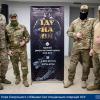Збирач потоків
I put together another free form Nixie Tube Clock
 | So, I tried to free form a similar clock I free formed earlier this year, except it includes the hours, minutes, and seconds. I wanted to see if I could possibly improve my free forming builds compared with the first clock I built, but honestly, it still came out ugly to me. At any rate, I kinda like the scraggly look of Freeform/dead bug electronics assembly. I’ll never be as good as Mohit Bhoite, Eirik Brandal, etc. However, I noticed that building stuff like this is calming to me. It’s difficult and stressful, although I find that when my job is pissing me off, I spent 15 minutes working on this clock to calm me down. The awesome part was after I assembled everything onto the base, I decided to just power it up and see if it worked. At first, I set my power supply to 12v and limited the current to 100mA. It powered up and hit the 100mA limit. I slowly increased the current, and when I hit 250mA, all the nixies counted down from 9 to 0, then counted up from 0 to 9, and displayed the time. Sort of. I had to ‘reset’ the DS1302 RTC, installed the button cell battery, and cycled the power…and it just worked. I set the time, and there it was, a working nixie Freeform clock! At first I was excited, then thought, “but now I have nothing to troubleshoot…” Where do I go from here? I don’t know; I may be seriously thinking about free forming Keith Bayern’s design, a discreet component nixie clock. That kit contains over 1,000 components, but it might be doable and pretty impressive lol [link] [comments] |
How to reinvent analog design in the age of AI

Where does analog design stand in the rapidly growing artificial intelligence (AI) world? While neuromorphic designs have been around since the 1980s, can they reinvent themselves with building blocks like field-programmable analog arrays (FPAAs)? Are there appropriate design tools for analog to make a foray into the AI space? Georgia Tech’s Dr. Jennifer Hasler, known for her work on FPAAs, joins other engineering experts to discuss ways of accelerating analog design in the age of AI.
Read the full transcript of this discussion or listen to the podcast at EDN’s sister publication, EE Times.
Related Content
- Inside the walls of FPAA maker Anadigm
- Field Programmable Analog and Gallium Arsenide
- Field Programmable Analog Arrays Get Larger and Cost Less
- Field-Programmable Qubit Arrays: The Quantum Analog of FPGAs
- Lowered Price for Field Programmable Analog Array (FPAA) Development Kit
The post How to reinvent analog design in the age of AI appeared first on EDN.
My first serious PCB, Digital Oscilloscope
 | submitted by /u/_RoseDagger [link] [comments] |
vtr of doom and despair
 | submitted by /u/Haunting_Ad731 [link] [comments] |
Weekly discussion, complaint, and rant thread
Open to anything, including discussions, complaints, and rants.
Sub rules do not apply, so don't bother reporting incivility, off-topic, or spam.
Reddit-wide rules do apply.
To see the newest posts, sort the comments by "new" (instead of "best" or "top").
[link] [comments]
Deep Brain Stimulation pacemaker on xray.
 | submitted by /u/nixxon94 [link] [comments] |
Зустріч з бійцями Сил спеціальних операцій ЗСУ
КПІшники зустрілися з бійцями Сил спеціальних операцій ЗСУ — військовими, які успішно виконуюють надскладні бойові операції на фронті й в тилу ворога.
This video provides an interesting lesson on how traffic lights are made using logic circuits.
 | submitted by /u/rodrigtti [link] [comments] |
DsPIC33CK adapter board I created in kicad to use this multi phase board.
 | Need to try still if it works [link] [comments] |
John Bardeen (left), Walter Brattain (right), inventors of the BJT. William Shockley (seated) took undeserved credit. All 3 shared the 1956 Nobel Prize in Physics.
 | submitted by /u/1Davide [link] [comments] |
Auction of CrayoNano’s assets extended to 17 March
Енерго-Інноваційний Хаб КПІ: рік досягнень та нових можливостей
Центр декарбонізації енергетики та Енерго-Інноваційний Хаб КПІ ім. Ігоря Сікорського в його складі активно розвиваються, впроваджуючи інноваційні рішення та укріплюючи партнерські зв’язки. За трохи більше ніж рік від створення Хаб уже досягнув низки стратегічних успіхів.
The downside of overdesign, Part 2: A Dunn history

Editor’s Note: This is a two-part series. Part 1 can be found here.
My father, John Edward Dunn, was a Foreman in the New York City Department of Bridges. His shop was in Brooklyn on Kent Avenue adjacent to the Brooklyn Navy Yard. His first assistant at that shop was a man named Connie Rank. Dad’s responsibilities were to oversee the maintenance and repairs of all of the smaller bridges in Brooklyn, Staten Island, and parts of Queens. The Mill Basin Bridge was one of his.
Dad was on call 24/7 in response to any bridge emergencies. At any time of day or night a phone call would come in and he would have to respond. When calls came in at 2 AM or 3 AM or whenever, the whole household would be awakened. Dad would answer the call and I would hear “Yeah. Okay, I’m on my way.” Then I’d hear Dad dialing a call where I’d hear “Connie? Yeah. See you there,” and that would be that. The routine was that familiar. Nothing further needed to be said. He wouldn’t get home again until at least 5:30 PM the following day for having responded to whatever emergency had occurred and then having worked a full day afterward without interruption.
Many of those emergencies were at the Mill Basin Bridge. One of them made the front page of a city newspaper. There was a full page photo of the bridge taken from ground level showing all kinds of emergency vehicles on the scene with all of their lights gleaming against the dark sky. Dad showed me that paper and asked “Do you see that little dot here?” I said “Yes,” and he said, “That little dot is me.” He knew where he had been standing.
Following one accident, perhaps it was the accident above, Dad apparently saved someone’s life. He was honored for that by Mayor Robert F. Wagner. Neither I at the age of twelve nor my sister at nine were ever told the details of the event, but it led to Dad shaking hands with the Mayor at New York City Hall.

John Dunn’s late father, John Edward Dunn, shaking hands with NYC mayor Robert F. Wagner circa 1956 to receive an award for his brave work saving a life as a foreman with the NYC Department of Bridges.
John Dunn is an electronics consultant, and a graduate of The Polytechnic Institute of Brooklyn (BSEE) and of New York University (MSEE).
Related Content
- The downside of overdesign
- Loud noise makers and worker safety
- RF power amplifier safety
- Fractured wires and automotive safety
- The headlights and turn signal design blunder
The post The downside of overdesign, Part 2: A Dunn history appeared first on EDN.





